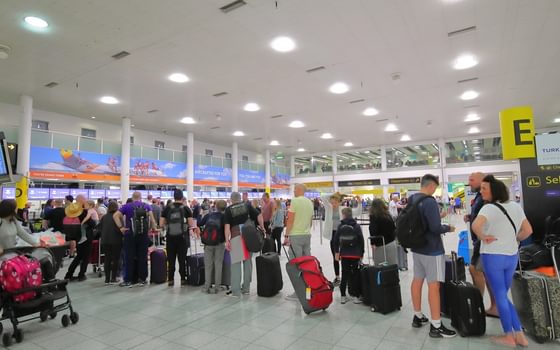Making polluters pay
How the Emissions Trading Scheme should be harnessed to benefit people and climate
18 December 2022
The fossil fuel emergency is escalating, driving a cost of living scandal at home, and intensifying climate-driven loss and damage overseas. The UK has committed to the principle that the ‘polluter pays’ for the environmental damage their activities cause. But the government’s spending on climate initiatives falls short of even the revenue collected from polluting businesses through its Emissions Trading Scheme. We have found that over £6bn will be raised this year, which could be invested in a Great Homes Upgrade for the UK, and compensating countries in the Global South bearing the brunt of climate damage.
What is the UK ETS?
The UK Emissions Trading Scheme (ETS) is designed to incentivise businesses to avoid pollution, and where pollution (in the form of greenhouse gas emissions) does take place, to ensure the business makes a payment to society for the resulting damage. A cap is also set on the total amount of pollution (ie specific greenhouse gases) that can be emitted by sectors covered by the scheme. This cap will decrease over time to help the UK meet its target to emit net zero carbon by 2050. Polluters are incentivised to reduce their emissions in order to cut their costs. The scheme currently applies to energy intensive industries, the power generation sector and, to a partial extent, aviation.
The UK ETS is not a mechanism designed to ‘pay for’ the UK’s transition to net zero emissions. The primary function of the scheme is not to raise revenue for the government, but to cap emissions and incentivise the private sector to reduce them. However, the UK government will need to invest significant public resources in delivering the green transition. In the long run this investment will deliver net positive returns to the government and the public as climate disaster is averted. Investment is needed to reduce emissions, to protect against climate damages at home and abroad, and to pay for loss and damage incurred by extreme weather events. This expenditure can, and should, be funded from a variety of sources including borrowing, general taxation, and central bank financing. However, it seems logical that, as a minimum, the UK government should be spending at least as much money on the green transition as it is raising through green taxes such as the UK ETS.
Expanding the UK ETS
The limited group of sectors covered by the UK ETS means that only a minority of the UK’s national greenhouse gas emissions are covered by the scheme. Key sources of emissions such as gas for home heating, petrol used in cars, and agricultural processes are not currently covered. However, given the imperative to reduce emissions the UK government recently ran a consultation on expanding the scheme, exploring the potential for the UK ETS to also cover domestic maritime, energy generation from waste, and some non-carbon gases emitted by aviation.
In the longer term, further sectors may be brought under its umbrella – but there are reasons to be cautious. Under the UK ETS, participating businesses must purchase ‘allowances’ to cover their annual emissions. These are purchased at auction or on the secondary market, where businesses can trade unwanted allowances with other participants. The revenues from the sale of allowances at the monthly auctions go into the Treasury. In some cases this could drive up the price of goods in the short-term (but potentially reduce prices in the long-term). For this reason, the government might not, for example, impose the UK ETS on the domestic gas market, with gas prices already at extremely high levels and causing major problems for UK consumers.
Historically, a proportion of the total pot of carbon allowances has been allocated for free (termed ‘free allowances’) to businesses in order to cushion the impact of the scheme and reduce the incentive for businesses to relocate activities to countries not inside the carbon market (termed carbon ‘leakage’). Expansion of the UK ETS might also include reducing these allocations so that businesses pay the full price for all of their emissions.
Government revenues from the UK ETS
To date, the revenue from the ETS auctions has been given limited public scrutiny, as the price for allowances was very low. Between 2012 and 2018 the price per tonne to emit carbon remained below €20 (at the time the UK was a member of the EU ETS), and up to half of all emissions covered by the scheme were passed on as free allowances. Since 2018 prices have risen sharply. A tonne of carbon now trades at around £80 in the new UK ETS and free allowances have fallen to around a third of emissions (see figure 1). This development, driven by a variety of factors, including the tightening of the overall emissions cap, results in quite substantial revenues accruing to the UK government.
Figure 1: The price per tonne paid by businesses regulated by the UK and EU emissions trading schemes has risen dramatically over the past two years.
Moving forward multiple factors will influence both the carbon price, and the amount of revenue accruing to the government. Fundamentally, the ETS is a scheme with built-in obsolescence: the overall pot of emissions allowances must fall to near-zero over time for the scheme to deliver on its primary purpose. The decline in the number of available allowances will put downward pressure on government revenues from the scheme, but this will be offset by opposite drivers, for instance, the expansion of the UK ETS into new sectors.
There is a strong climate argument for reducing the allocation of free allowances and further increases in government revenues are a likely by-product of doing so. Research has suggested that between 2008 and 2019 businesses were allocated many more free allowances than they needed to function competitively. Recent research also suggests that previous concerns about ‘carbon leakage’ have proven largely unfounded. Instead, free allocations have simply slowed emissions reduction progress. There is also evidence of companies profiting from selling freely allocated allowances and then seeking state aid. As a result, the UK government recently consulted on the phase-out of some free allowances.
Increases in the price of carbon as the scheme’s overall emissions cap falls are also likely to increase the potential revenue pot of the ETS. There is strong evidence that current ETS prices are not high enough to deliver industrial emissions reductions at the pace needed. The government produces its own series of what it considers to be the value of carbon which will be required for us to meet our legal emissions targets. This forecast, shown in figure 2, of the Department for Business, Energy and Industrial Strategy (BEIS) carbon values, suggests short-term prices under the ETS are significantly lower than the value society places on a tonne of carbon. For its recent Jet Zero strategy on the future of aviation, the Department for Transport (DfT) developed an illustrative trajectory for the future of the ETS price. As shown below, the government expects the price to rise over coming years, albeit only aligning with the true ‘carbon value’ in 2050.
Figure 2: At present the price paid per tonne of CO2 equivalent emissions is considerably lower than the ‘carbon value’ to society calculated by BEIS, but the DfT expect this gap to close over time in the aviation sector.
Guided by the DfT’s forecast of future ETS prices, and reasonable expectations of the expansion of the scheme into new sectors, we have produced forecasts of future government revenues arising from the ETS. We assume that the new total emissions cap proposed in the recent ETS consultation is delivered, and that policies relating to the distribution of free allowances and introduction of new sectors play out as proposed by the government. On this basis our modelling suggests that annual government revenue from the auction of allowances will remain above £5bn all the way to 2030, peaking at around £6.6bn in 2023 (see figure 3).
Figure 3: NEF modelling suggests government revenues from the UK ETS will remain above £5bn per year until at least 2030. This represents a dramatic increase when compared with the revenues expected by the OBR in 2021.
The value of freely allocated allowances remains above £3bn over the period to 2030 as the government’s current plans only gently curtail these allowances. The sharp rise in the cost per tonne of emissions sees the value of the free allocations leap by almost £1.5bn between 2021 and 2022 (see figure 4).
Figure 4: NEF modelling suggests the value of emissions allowances allocated to companies for free will remain above £3bn per year until at least 2030.
As shown in figure 3 above, the Office for Budget Responsibility (OBR) has been remarkably inaccurate in its forecasts of ETS revenue. In March 2021 the OBR expected £1.2bn from the ETS in the financial year 2022/23, but by November 2022 this forecast had been revised up to £6.1bn. In reality, our analysis suggests the true value is likely to approach £6.5bn. In the space of just one year, the government’s own expectation of how much income it would receive from the ETS over the four year period between 2022/23 and 2025/26 rose from £4.9bn to £23bn. Our analysis puts the equivalent figure at £23.8bn, with at least £53bn to be raised by 2030.
To put this scale of revenue raising in perspective, in its October 2021 Spending Review (p.73), the Treasury estimated the government’s entire outlay on what it calls “core net zero spend” at £5.5bn for the year 2022/23. In other words, this financial year, the government will raise over half a billion pounds more from its carbon taxation mechanism than it will actually spend on climate policies. An even greater gap exists between current spending and the Climate Change Committee’s estimate that in 2022/23, over £12bn of capital investment is needed in just the buildings and transport sectors.
The comparisons we make here are for illustrative purposes. In reality, a majority of the outgoings under the government’s £5.5bn expenditure on net zero are investments with a return. The government’s £1.4bn investment in decarbonising the public sector, for instance, will have significant benefits in reducing public sector energy bills and other building maintenance costs. Such investment can be financed through borrowing or other capital expenditure lines and do not require revenue raising through taxes.
Spending UK ETS revenues
In reality revenue raised through the UK ETS is small relative to government expenditure. Yet there is a legal argument to be made that the UK government is obligated to match increases in ETS revenue with increases in expenditure on mitigating climate damage. In 2021 the government set out clear guidance in its new Environment Act and subsequent Environmental Principles Policy Statement. In these principles the government commits to the ‘polluter pays’ principle, stating: “In cases where pollution cannot be avoided or is caused by accident, the polluter pays principle can be used to restore or redistribute the costs of environmental damage.”
The societal cost of carbon emissions is set out in the government’s ‘carbon values’ and currently comes in at a level significantly higher than the price being charged to businesses through the ETS. On this basis, we might expect the government to spend at least an amount commensurate with the total raised through the ETS to “restore or redistribute the costs of environmental damage” resulting from greenhouse gas emissions. As not all of the UK’s emissions are covered by the ETS, and the ETS is currently charging emissions at a level significantly lower than the ‘carbon value’, the government should either be spending a significantly larger amount than is raised through the ETS or should be tightening legislation to ensure businesses do so.
Recent research suggests most European countries participating in the EU ETS spend the majority of the funds raised on climate action, with Germany and Greece reportedly spending 100% on climate action, and Portugal and France spending 90%. The EU Commission’s latest proposal to amend the EU ETS proposes that member states spend all ETS revenues on climate and energy-related projects. Calculating the UK’s equivalent figure is challenging. Our assessment of the net zero spending commitments made in the 2021 spending review suggests the increase in the government’s outlay on climate action is equivalent to around 20% of our estimate (Figure 3) of the rise in revenue generated by the UK ETS this year (2022/23), rising to 69% in 2024/25. These estimates assume the government maintains the level of net zero spending growth committed to in the October 2021 spending review, something which may now be in doubt given the real-terms spending cuts seen in the 2022 Autumn Statement.
The UK should follow European examples and ensure revenue raised through the ETS is matched with commensurate spend on climate action at a rate of 1:1. Two areas stand out as requiring immediate attention: domestic housing retrofit and supporting foreign nations already experiencing loss and damage.
Bringing down household energy use and bills
Households are facing a severe winter, with up to 8.5 million households being forced to choose between eating or heating (or going without either). Following a surge in gas prices, this government has capped net average household energy expenditure at £2100, at great cost to the public purse. But this level still represents a 64% increase on the average household expenditure one year earlier (£1277). It is imperative that we make a swift switch away from fossil fuels towards renewables, which are cheap, clean, and secure. It is also crucial that energy demand is reduced, and with this, our exposure to Russian gas. To bring down bills, and to meet our climate targets, we will need to retrofit at least 19m homes by 2030.
The October 2021 spending review allocated £1.75bn to home upgrades and decarbonisation of social housing up to the end of the current parliament (2024/25). Despite the commitments in the spending review and the government’s heat and building strategy, there is an estimated gap of £8.75bn in public spending before the end of this parliament, if we are to meet our net zero climate target. This amount is comfortably matched by the uplift in funding expected from the UK ETS over the next 2.5 years. A war-time-level effort to insulate homes and roll out heat pumps is affordable and a prudent investment for both households and the public purse.
Acting in solidarity with people at the forefront of climate impacts
Emissions from activities in the UK impact the global community. Populations in climate-vulnerable countries with little resource to respond to and cope with escalating extreme weather events are hardest hit by a warming planet. Estimates for climate-fuelled damages in developing countries, such as the floods seen this year in Pakistan, range from between $290 to $580 billion by 2030. Providing finance for climate-vulnerable communities is about recognising the outsized role that the UK has played in causing the climate crisis, and acting in solidarity with those who are bearing the brunt of its impacts while contributing little to the crisis themselves.
Developing countries have been calling for ‘loss and damage finance’ since 1991 and finally secured a commitment from the international community at this year’s UN climate conference, though it remains to be seen how much money will be forthcoming. A recent study found that 55 of the most climate-vulnerable countries have already experienced over $525 billion in climate-induced economic damages since 2000. Scotland was the first country to explicitly put money towards helping developing-country communities after climate-induced events hit. The UK must follow suit in committing finance, that is new and additional to existing Overseas Development Assistance, to address loss and damage. Using some of the revenues from the UK ETS for this purpose would be a crucial signal of international solidarity and cooperation, and would help secure a positive legacy for the UK as COP 26 president.
The five-fold increase in revenue expected from the UK ETS is a windfall to the government at an opportune moment. There are strong moral, legal and financial arguments backing the use of these new funds to urgently invest in averting climate disaster, both at home and overseas. With astronomical fossil fuel prices crippling UK households, and climate-driven damages accelerating overseas, a Great Homes Upgrade, and Loss and Damage finance mechanism are the places to start.
Image: iStock/Ceri Breeze






